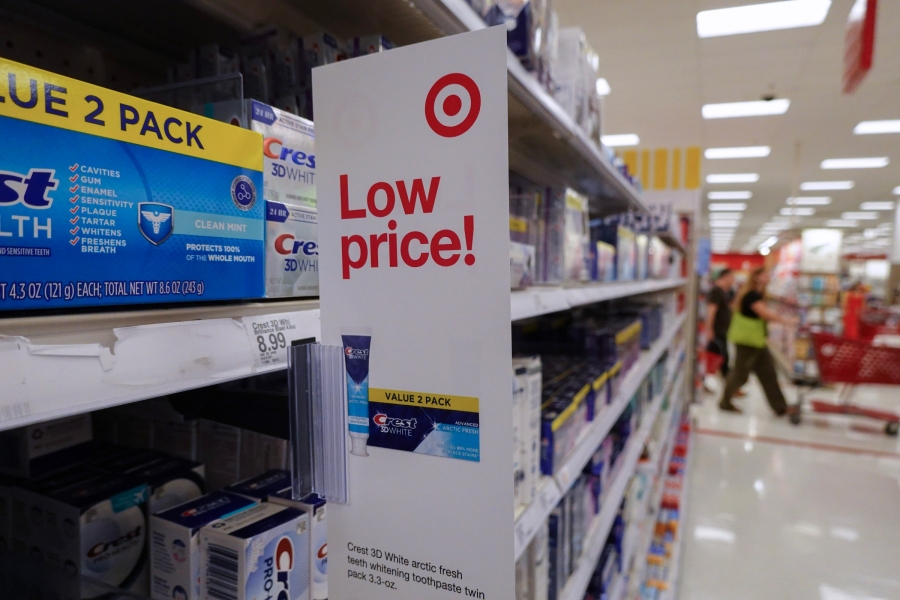
Grocery retailers would like to make an announcement: They’re listening to customers and lowering their prices. The news that Target plans to cut prices on about 5,000 everyday items — things like bread, milk, and diapers — made an especially big splash last week. But the big-box retailer wasn’t alone. In early May, grocery chain Aldi said it would cut prices on over 250 items. Walmart has noted in recent earnings calls that it’s offering more discounts as well as lower prices in general on certain grocery items. (Retailers outside of the grocery business too, have made it known that they’ll be charging slightly less for their goods, including Ikea and Michaels.)
These announcements might have you believing that consumers will finally stop wincing in the checkout line. Consumer prices have gone up about 19 percent since 2021, but grocery prices have jumped by about 25 percent. While inflation, which measures the rate of price changes, is around 3.4 percent right now, way down from the peak of 9.1 percent we saw in June 2022, that hasn’t meant food prices (in most cases) have gone back down. Now, a flurry of headlines is heralding these price cuts as proof that companies are finally relenting to consumer fatigue with inflation prices. Relief is in sight.
But why is this happening now, when people have been feeling the pinch for years?
The answer to that might seem obvious, but it’s worth underscoring: It happens to be a ripe time for retailers like Target to turn the dial slightly down on profit margins in the hope of selling a higher volume of stuff. More than anything, declarations about cutting prices arouse a whole lot of media buzz that budget-conscious customers will pay attention to. It’s a savvy play for shifting perceptions of value, crucial for consumers in the decision-making process of where to shop for bread and eggs. Customers benefit by saving some money; retailers possibly benefit even more by being known as the company that magnanimously trimmed prices.
Where prices are getting snipped, and how much it will help
Target hasn’t rolled out all of its planned price cuts yet; so far, it has reduced prices on about 1,500 items. Examples of these cuts include a pound of Good & Gather Unsalted Butter — from Target’s private food label — selling for $3.79 instead of $3.99. Other private label reductions include its Good & Gather organic baby spinach, down to $2.99 from $3.29, and Good & Gather sea salt roasted nuts reduced to $5.29 from $6.89. But brand names are included in the price slashing too, including Clorox, Huggies, Pepperidge Farm, and Aveeno products.
Target says it’s homing in on frequently bought items like “milk, meat, bread, soda, fresh fruit and vegetables, snacks, yogurt, peanut butter, coffee, diapers, paper towels, pet food.” When asked for a more detailed list of Target products due for a price cut, a spokesperson declined to share more than the examples listed in the press release.
While a planned price reduction on 5,000 items isn’t nothing, it’s also a drop in the bucket compared to all the items sold by Target stores across the country. On the other hand, price cuts are a great opportunity for retailers to push their private labels, since these often enjoy cushier margins on these products and can also afford to price them more cheaply than other brand names. Target recently launched a budget-friendly private label called Dealworthy for everyday items like paper towels, toothbrushes, or charging cables, most of which are under $10. (Walmart and Aldi both also have their own ranges of affordable private label brands.)
“We’re not going to see the return of 2019 pricing”
Walmart noted in its most recent earnings call that it had lowered the price of its French bread back to $1 and that it had increased the number of rollbacks — the famous Walmart term for temporary discounts — by 45 percent compared to this time last year.
Earlier this month, Aldi also announced 250 price cuts throughout the summer. A pack of macarons is down to $4.19 from $4.59. A pound of USDA Choice Black Angus Sirloin Steak was $8.49 but is now $6.99, which is a meaty discount. But, crucially, some of these deals won’t last long; the fine print notes that the steak is only on sale through July 10.
This highlights another aspect of the recent price reductions: How long will these price cuts last? Are they permanent? “No one really knows the answer to that,” says Neil Saunders, managing director of retail at the consulting firm GlobalData. “I would think Target is making these reductions with the intention of having them be permanent.” But he notes that not all retailers are taking that approach. Some of these reductions, like Aldi’s, are clearly intended to be temporary. Amazon unveiled some price cuts from May 25 to June 19 on a bunch of their essentials, including their grocery products on Fresh.
“Eventually, prices will change — inevitably, that’s what happens,” notes Zak Stambor, senior analyst of retail and e-commerce at market research firm eMarketer. But Target’s cuts are probably in play for the next several months, at least.
Nor are the reductions going to drastically change your grocery bill. “They’re not going to slash prices, they’re just modestly bringing levels down,” says Saunders. “And of course, we’re not going to see the return of 2019 pricing.”
Why are prices coming down now?
No business would lower its prices if it didn’t think the move would benefit the company in some way. For Target, price cuts did a couple things. First, it got them positive attention ahead of what it knew would be a fairly disappointing earnings report a few days later.
“Their earnings weren’t particularly good,” says Stambor of Target’s performance in the first quarter of 2024, which showed a fourth consecutive drop in sales.
Part of Target’s problem is the brand is known for its wide array of home goods. The common joke about shopping at one of its stores is that you walk in needing one thing and walk out with three candles, two bottles of nice hand soap, a new set of bath towels, a throw pillow, and a welcome mat with a cutesy-cringe phrase on it.
“Target’s in a tough spot: They rely on discretionary spending, and consumers have largely pulled back on non-essential spending,” Stambor says. In its most recent earnings report, Target noted that its sales had fallen in the last quarter across multiple categories, including home goods and groceries. (Sales in its beauty segment, though, grew.) In an earnings call, executives discussed that consumers were still spending “cautiously, particularly in discretionary categories.” Timely price cuts that consumers will love are something the company could highlight in its earnings report to reassure investors. They’re also a step in the right direction for shifting customers’ value perception of the brand.
Its competitor Walmart, meanwhile, has drilled into consumers’ minds that it is all about low, low prices; its private label grocery line is called Great Value. Aldi, though much smaller than Walmart, is also a grocery favorite for offering surprisingly low prices. To keep up in a space that’s dominated by giants like Walmart and other low-priced options, Target wants an image shift: Its food and essential offerings can be cheap, too. Target has recently redoubled its efforts to gain sales in groceries and, earlier this year, it launched its affordable household goods brand Dealworthy.
The splashy price cuts, in other words, are “very much a Target response to a Target problem,” according to Saunders. Walmart, meanwhile, continues to offer discounts and lower prices to stay ahead in a competition it’s already winning.
For the past few years, several food and grocery retailers have embraced higher prices even at the expense of falling sales numbers. But the rush to signal that they’re now lowering prices may be a sign that the balance is tipping as companies chase higher sales over higher prices. It’s not just grocery chains, either. Giant food brands like PepsiCo and fast food chains like McDonald’s have seen their sales dip in the most recent quarter. Retail is extremely competitive right now as companies vie for market share among consumers who are being choosy about where they spend their tightly budgeted money.
Why the message matters
Most importantly, the theater of making grand pronouncements about lower prices is great for retailers’ reputations. Forget about all the price hikes grocery retailers and food brands implemented in the last few years — now companies would like consumers to focus on the savings they’re offering. “They’re all leaning into this inflation-oriented messaging,” says Stambor, which he notes is interesting because food inflation isn’t high at the moment. It’s the accumulation of past inflation that we’re still feeling the sting of; the prices just didn’t come down.
“They got headlines, they got my mom to call me and say, ‘Wow, Target is cutting prices’”
But framing counts for a lot in how people view a brand’s value, and so retailers are running with the narrative that they’re sensitive to consumers’ frustrations with “inflation.” Take the case of Wendy’s highly unpopular dynamic pricing fiasco from a few months ago: A comment from one of its earnings calls went viral, with the public interpreting it as Wendy’s implementing surge pricing for its burgers and fries. The reality was that it would probably use algorithmic pricing to suss out when and where to offer promotional deals that would drive more sales, but the negative press couldn’t be tamped down.
While the Wendy’s scandal shows what can happen when a company isn’t careful with its words and framing, positive write-ups about Target’s price cuts show the impact a carefully placed press release can make on a brand’s perception. It can conjure the aura that a brand is becoming a lot more affordable, even if that’s only true for a certain portion of its offerings or only for a limited time. The Biden administration has taken credit for Target’s latest move, pointing to the pressure it has placed on food and grocery retailers about high prices and corporate profiteering. Retailers, to no one’s surprise, very strategically announce any promotional deals or other price cuts they’re planning because they know it’ll create positive emotions. Earlier this year, Kroger declared that it would be able to offer lower prices after it merged with Albertsons, a deal the FTC has sought to block.
The biggest winner of Target’s price cuts is, in other words, Target. “They got headlines, they got my mom to call me and say, ‘Wow, Target is cutting prices,’” says Stambor.
Source: vox.com






